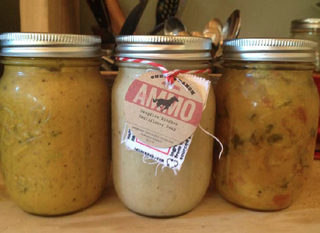Being public is double-edged: great benefits by electronically and almost instantly connecting with individuals and food safety types around the world, with the risk of being a bigger target for every food-related (or other) grievance.
We encourage food types take to McLuhan’s mediums, and to fight back if wrongfully implicated.
 But have some data.
But have some data.
The most common myths that permeate public conversations are food is automatically safe if:
• the bathroom’s clean;
• it’s local, organic, sustainable, natural;
• it’s government inspected; and,
• because we’ve always done things this way and never had a problem.
In 2011, a 29-year-old man was hospitalized after five days of progressive dizziness, blurred vision, dysphagia, and difficulty breathing. The patient required mechanical ventilation and botulism antitoxin. He remained in the hospital for 57 days and then spent some time in a rehabilitation facility. According to the U.S. Centers for Disease Control, he had tasted some potato soup that included botulinum toxin.
In 1977, 59 patrons of a Detroit Mexican restaurant became ill with botulism after consuming improperly canned peppers. As a result of rumors of a pending shortage of fresh peppers, the restaurant staff decided to stick lightly-cooked peppers and some water in jars and seal them.
Putting low acid foods in a jar and sealing them without either acidifying (with vinegar/fermentation) or processing using pressure is a bad idea.
Earlier this week, the California Department of Public Health (CDPH) urged people to avoid and dispose of One Gun Ranch and Organic Soup Kitchen soups sold at farmers markets in California because they potentially contained botulinum toxin. The vendors involved are saying they didn’t know the rules (or the risks). And it’s apparently the regulators fault for not letting them know.
According to Squid Ink, although none of One Gun Ranch and Organic Soup Kitchen products tested positive for the toxin (fortunately), the process/procedure to limit the germination of Clostridium botulinum and toxin outgrowth wasn’t validated by anyone. And the companies are crying fowl.
The companies targeted by CDPH are reeling from the state’s actions against their products.
"We have fed over 50,000 people in three years without incident," says Anthony Carroccio, founder and director of the Organic Soup Kitchen, which feeds homeless and low-income .jpg) people in Santa Barbara.
people in Santa Barbara.
Carroccio told us that there is nothing wrong with his soups and said that the company passed its most recent county health department inspection two weeks ago. He said the company has never had a recall of any of its products: "We do everything by the letter of the law."
Asked why the state health department is suddenly taking this action against the Organic Soup Kitchen, Carroccio responded: "That’s what I wish somebody would tell me."
Malibu-based One Gun Ranch emailed a statement to Squid Ink, saying: "The mandatory recall of our products is a result of further licensing requirements by the local health department in order to comply with state regulations. It was not a result of contaminated food or improper preparation of our jarred food products. In addition, the commercial kitchens used to prepare One Gun food products adhere to the highest standards of operation and regulations required by the CDPH."
One Gun Ranch CEO Jennifer Hozer told us in a phone interview, "Our understanding is it’s a paperwork issue. … Even though we’re doing everything, there’s a process you have to go through that we weren’t aware of, that they didn’t make us aware of, where they basically observe how you do it. Once that happens, we’ll be fine. Our practices are in place. In all honesty, the way we do it is above and beyond what they require. It’s just a matter of them seeing it."
Hozer added: "We want to protect our customers as well. We understand why they had to do what they did, as far as issuing the recall. It’s just unfortunate that it had to be with a scare tactic, causing fear of the product. We’ve all eaten the food, [and] nobody’s ever gotten sick."
Double points for two we’ve-never-made-anyone-ill comments in the same story. A better answer would have been to talk about the exact processes they use to limit the potential for botulinum toxin formation and how those processes have been validated. In the absence of that info, a lack of illnesses or issues is usually luck.
The idea of prevention is to prevent – before people get sick.







 But have some data.
But have some data..jpg) people in Santa Barbara.
people in Santa Barbara. can flourish.
can flourish. • a plastic plant pot was used to sieve chickpeas and the conveyor, which turned out thousands of cans of pulses each day, had also been used to tin chilli hemp seeds for fish bait;
• a plastic plant pot was used to sieve chickpeas and the conveyor, which turned out thousands of cans of pulses each day, had also been used to tin chilli hemp seeds for fish bait; Since arriving in North Carolina, Chapman has converted from a former Toronto Maple Leafs hockey fan to a Carolina Hurricanes fan.
Since arriving in North Carolina, Chapman has converted from a former Toronto Maple Leafs hockey fan to a Carolina Hurricanes fan. .jpg) Chapman even spent a semester working as a dishwasher in a restaurant to get a better sense of what the work climate was like.
Chapman even spent a semester working as a dishwasher in a restaurant to get a better sense of what the work climate was like.